By Santorini Dave • dave@santorinidave.com
My Favorite Hotels in Singapore
• 5-star: Raffles
• 4-star: Fullerton
• 3-star: lyf Bugis
• For families: Ascott Orchard
• For couples: Naumi
• Best pool: Marina Bay
• Best airport hotel: Crowne Plaza
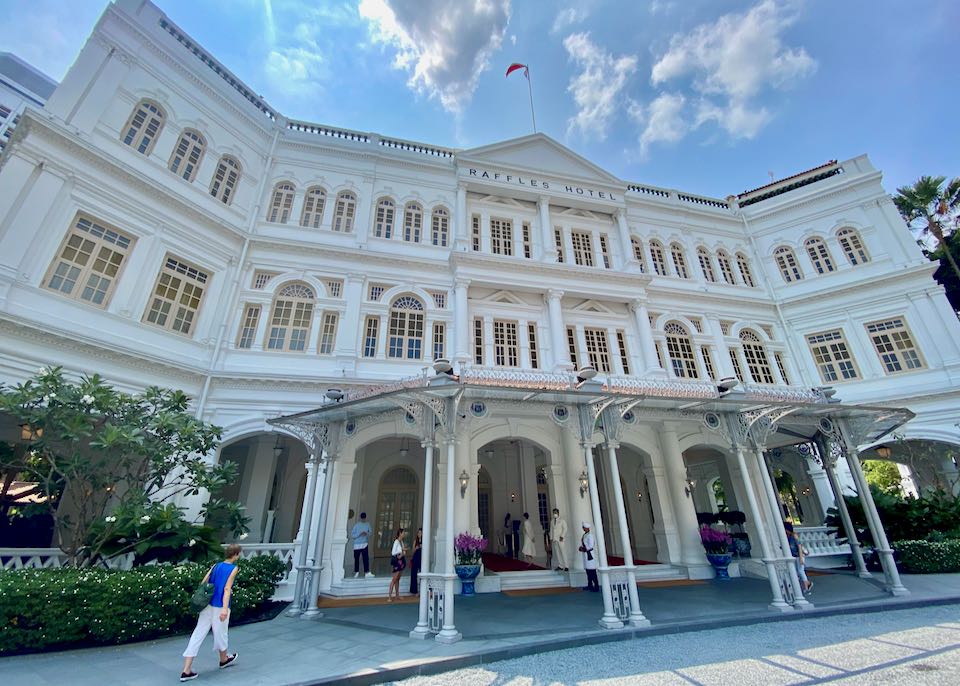
The historic Raffles Hotel, an iconic symbol of luxury and the birthplace of the Singapore Sling cocktail.
Staying close to the city’s excellent Mass Rapid Transit system (MRT) is highly recommended regardless of which neighborhood you choose. The system has 140 stations across six MRT lines. Stations that have stops for multiple lines are extra convenient.
Singapore hotels near MRT stations: JW Marriott South Beach (Esplanade station) • Capitol Kempinski (City Hall station) • Conrad Centennial (Promenade station) • Orchard Parksuites (Orchard station) • Andaz by Hyatt (Bugis station) • Paradox Merchant Court (Clarke Quay station)
On Booking.com MRT stations are shown with the station name in blue (Raffles Place) and colored station codes (East-West Line, stop number 14 and North-South Line, stop number 26).
The Best Areas To Stay in Singapore
Dangling off the southern edge of Malaysia, Singapore has transformed from a virtually empty malarial swamp into one of the world’s greatest cities, largest ports, and busiest transport hubs in less than 200 years, particularly since the 1970s. Yet, Singapore remains quite unique: overwhelmingly populated by descendants of migrants from China and, to a lesser degree, India and Malaysia. One of the very few countries based almost entirely around a single city, it happily maintains and promotes its colonial heritage.
Nearly six million people are squeezed into an area about 31 miles by 17 miles, a land size that has increased by an incredible 25% due to reclamation in a few decades. In the city center, the Colonial District is jam-packed with attractions – from the Bugis Street Market to the National Museum and other colonial-era buildings like the iconic Raffles Hotel, one of many fantastic hotels in the city, and the original home of the Singapore Sling cocktail. Heading west from this area, Orchard Road satisfies the two major passions of locals and tourists: shopping at the 20+ malls and eating among the endless world-class bistros and authentic food courts.
Alongside the Colonial District is Marina Bay – an extraordinary area of reclaimed land packed with the city’s flashiest hotels and dominated by the colossal Marina Bay Sands hotel complex and the futuristic Gardens by the Bay next door. Meandering inland from Marina Bay, Singapore River was an impoverished village of junk boats just a couple of decades ago but is now lined with beautifully restored colonial buildings, high-rise hotels, and inviting bistros, bars, and nightclubs.
South of the river, Chinatown is perhaps the most authentic of its kind on the planet and particularly vibrant during the city’s numerous festivals. Also home to a mosque and Hindu temple, it’s a fascinating area for exploring on foot and tucking into bowls of noodles. Microcosms of the other two major races in Singapore are Little India, filled with inviting cafés, fascinating temples, and affordable hotels; and Kampong Glam, the Malay and Arab district dotted with mosques, markets, and inexpensive eateries.
And off the south coast of Singapore, Sentosa Island is one of the most exhilarating places on earth for families and equally popular for others because of its marina and golf courses. The numerous mega-resorts offer plenty of amenities for children but most are more interested in all the amazing theme parks and outdoor activities around the island.
The Best Places to Stay in Singapore
The rooftop bar and pool at Naumi Hotel in central Singapore.
- Best Luxury Hotels in Singapore
Marina Bay Sands • Raffles • Shangri-La • Fullerton Bay • Capitol Kempinski • Grand Hyatt • Four Seasons- Best Boutique Hotels in Singapore
Naumi • Hotel Fort Canning • QT Singapore • Wanderlust • Vagabond Club • D’Hotel • The Scarlet- Best 3-Star/4-Star Hotels in Singapore
Fullerton • Conrad Centennial • Capella • W – Sentosa Cove • Holiday Inn Orchard • Ibis Bencoolen • Amara Sanctuary • ONE°15 Marina- Best Apartments, Suites, and Villas in Singapore
Ascott Raffles Place • Heritage Collection on Clarke Quay • Fraser Place Robertson Walk • PARKROYAL on Pickering • Resorts World Sentosa – Equarius Villas- Best Family Hotels in Singapore
Shangri-La • The St. Regis • Sofitel Sentosa Resort & Spa • Shangri-La Rasa Sentosa- Best Cheap Hotels in Singapore
Circular House • Royal Lodge • lyf BugisBest Areas in Singapore for…
- Best Area in Singapore for Sightseeing: Colonial District
This inner-city area offers plenty of must-sees packed into a compact area that is also very attractive and comparatively quiet. Highlights include the Bugis Street Market, once a red-light district and now a vast undercover shopping area; the National Museum, the city’s oldest and finest; the National Gallery, the biggest in Southeast Asia; and the Peranakan Museum, with displays about the unique culture of descendants of Chinese and Malays. And it’s almost obligatory to finish at least one day of sightseeing with a Singapore Sling cocktail at the iconic Raffles Hotel.- Best Area in Singapore for Nightlife: Singapore River
This modest river is lined on both sides with trendy places to eat, drink, and socialize until late into the night. Stroll along the waterside paths or take water-taxis to check out the extended choice of bars and nightclubs, some in converted warehouses at what was a poverty-inflicted area of junk boats less than 40 years ago. Most bars offer food and a few double as micro-breweries, while all sorts of music is offered from live jazz, blues, and rock to funky DJs towering over impossibly crowded dance floors. Especially vibrant and historic around Clarke Quay and Robertson Quay.- Best Areas in Singapore for Food & Restaurants: Chinatown and Little India
While some of the poshest bistros in Asia are within the Colonial District and the top-end hotels around Marina Bay, it makes sense to enjoy local cuisine in a country overwhelmingly populated by Chinese. The narrow lanes and frenetic markets of Chinatown are chock-full of eateries – from simple noodle cafés to world-class restaurants serving Peking Duck and dim sum. Another classic Singapore experience is the ‘banana leaf’ restaurants at Little India where waiters dollop curries, rice, and lentils onto banana leaves and diners scoop up the delicious food by hand.- Best Area in Singapore for Families: Sentosa Island
About half a mile off the southern coast of the mainland, this resort island is hugely popular among families who often stay at one of the massive resorts that offer a children’s pool, special large rooms, and enjoyable activities for all. There’s certainly enough to easily occupy an entire week, and almost everything is connected by the Sentosa Express monorail or free tram. Outdoor fun includes cycling, swimming, and water-sports, but most come for the theme parks like Universal Studios and other world-class attractions, such as the vast waterpark and magnificent aquarium. And it’s even heaps of fun just getting there by cable car from the top of Mount Faber.
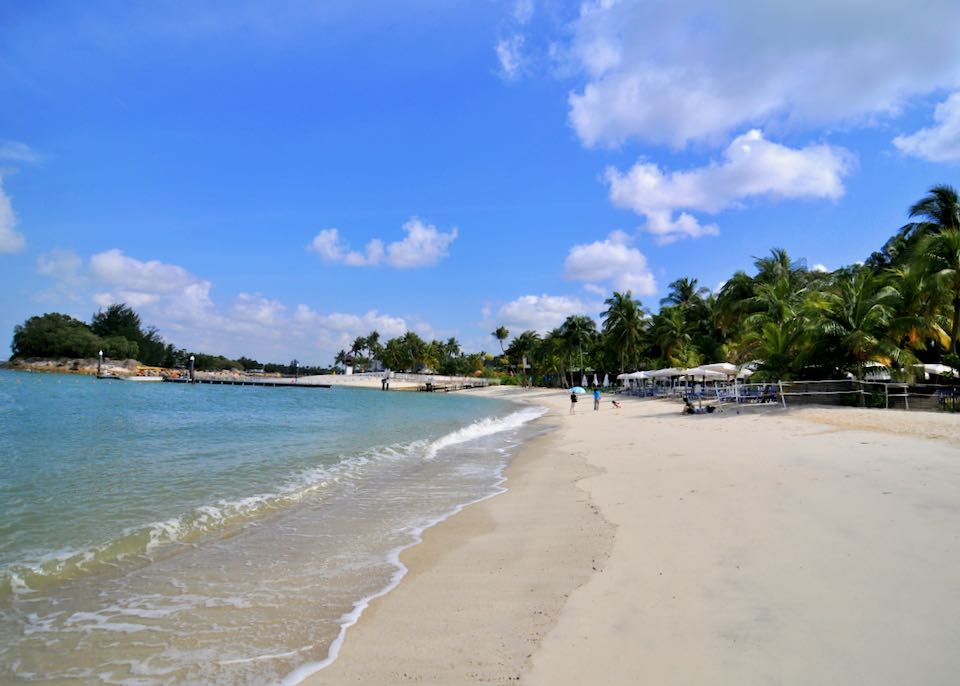
If you want beaches and beach resorts then stay on Sentosa Island – central Singapore is still easily accessible by taxi or public transportation.
- Best Beaches near Singapore: Sentosa Island
Most visit Sentosa for the fantastic range of theme parks and other indoor attractions like the aquarium, but there is also plenty to do outside. Most resorts rent out bicycles which can be used along dedicated paths distant from traffic. Swimming is possible along artificial sections of the coastline with golden sands and beach clubs. And a modest range of water-sports, such as wind-surfing, kayaking, and water-skiing, are also available.- Best Area in Singapore for Vibe and Culture: Chinatown
This Chinatown within a Chinese city is arguably the most authentic of its kind on the planet. The narrow streets are filled with chaotic markets, traditional-style cafés, and colorful Chinese temples, as well as a revered mosque and a Hindu temple. Unsurprisingly, there is no shortage of places to eat, including some of Asia’s tastiest dim sum, and the streets are particularly exotic during one of the city’s many festivals. First stop should be the Chinatown Heritage Centre to learn about Singapore’s short but remarkable history.- Best Area in Singapore for Shopping: Orchard Road
Perhaps as renowned as some shopping streets in New York and Paris, Orchard Road is nearly 2 miles long and filled with places to spend, spend, and spend some more. The 20+ malls and numerous markets offer anything and everything from international-brand boutiques to souvenirs such as jade, porcelain jugs, batik shirts, soothing Tiger Balm, and bak kwa (chewy pork strips) – but stick to the malls if receipts, guarantees, and authenticity are required. Near the end of the road, which is paralleled by an MRT metro line, is the perfect place to relax after all that shopping: the Botanic Gardens.- Best Area in Singapore for Walking: Colonial District
Unlike Chinatown, Little India, and Orchard Road, the inner-city Colonial District is not always clogged with traffic and the streets are wide and, often, shady. There’s plenty to explore on foot, including the city’s finest museum and region’s largest art gallery, as well as St. Andrew’s Cathedral and Victoria Theatre. Particularly inviting are the leafy oases of Fort Canning Park and colonial-era Padang (town square), now often used for cricket matches.
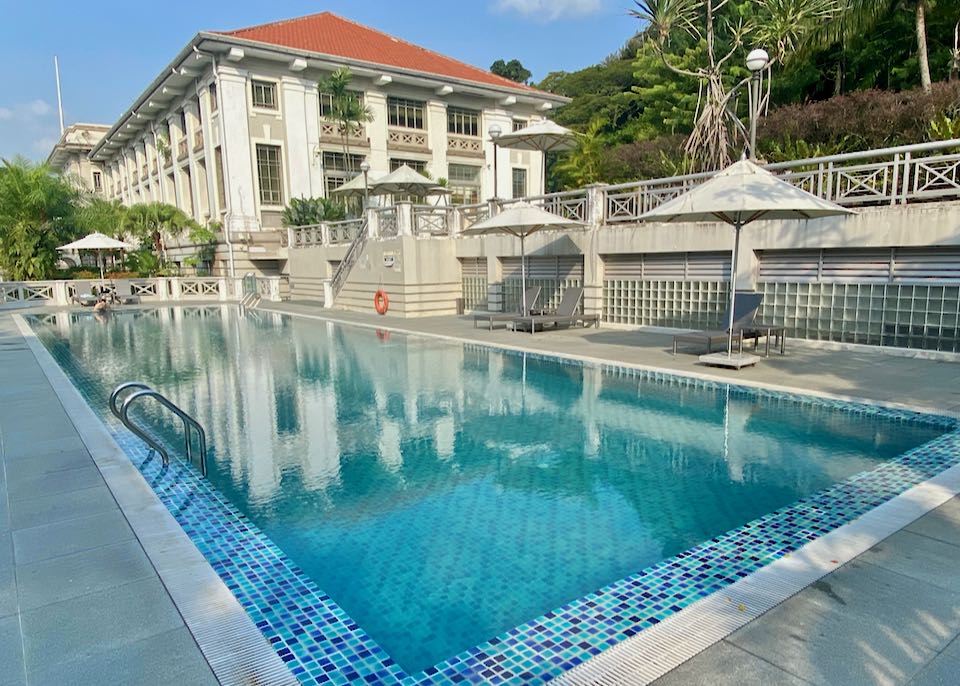
The large outdoor pool at Hotel Fort Canning.
- Best Area in Singapore for Transport: Colonial District
Highly efficient and very affordable, the MRT metro system crisscrosses the city with five lines, is used by over three million passengers per day, and also connects many outlying attractions and the airport. While there’s plenty to see on foot in and around the Colonial District, at least one of several MRT stations across three lines are within a brief stroll of every hotel in the area, and the stations are often connected by underground malls.- Best Area for Saving Money: Little India
It’s easy to save money by eating at simple cafés catering to locals and using the excellent public transport system which is pleasingly inexpensive. The overwhelming daily cost, however, will be accommodation. Singapore is one of the least affordable city-holiday destinations on earth and budget-priced hotels are rare and often not highly rated. In fact, space is so limited that many ‘capsule’ and ‘pod’ hotels/hostels are opening up, offering coffin-like beds with shared facilities. Sill walkable to Orchard Road and the Colonial District and well-connected by the MRT metro, Little India has many affordable hotels and inexpensive restaurants. (Most won’t sell alcohol, which is also overpriced.)- Most Romantic Area in Singapore: Singapore River
This unassuming waterway winds its way east from the hilly interior to the extraordinary Marina Bay, which is built on reclaimed land and virtually a freshwater reservoir. Both sides of the river are dotted with adorable colonial-era buildings, including museums and art galleries, as well as inviting bars, bistros, and nightclubs, some in converted warehouses. Particularly atmospheric after dark and during the city’s numerous Chinese festivals, there is no finer way to appreciate the river than on a cruise, which often includes dinner.- Best Area in Singapore for First-Timers: Marina Bay
It doesn’t take long to realize that Singapore is exceptionally uncomplicated: it’s compact, almost every Singaporean speaks English, all signs are in English, and the public transport system is first-rate. Built mostly on reclaimed land, Marina Bay offers considerably more space than elsewhere in this densely populated city, and the range of places to stay and eat are top-notch. All hotels in this area are within walking distance of outstanding attractions, such as the Gardens by the Bay, Singapore Flyer, and sound and light show. Also, just a short trip by metered taxi (or MRT metro) to all the other sights and amenities within the city center.- Safest Area in Singapore: Marina Bay
No area within Singapore is particularly unsafe, but with millions of residents and so many tourists, opportunistic petty crimes like bag-snatching and pick-pocketing are always possible. Take the usual precautions, especially around crowded streets and markets in Chinatown and Little India, and on public transport which can get very crowded at peak times. The safest area is Marina Bay, a modern and spacious expanse with wide and well-lit streets.The 8 Best Neighborhoods in Singapore for Tourists
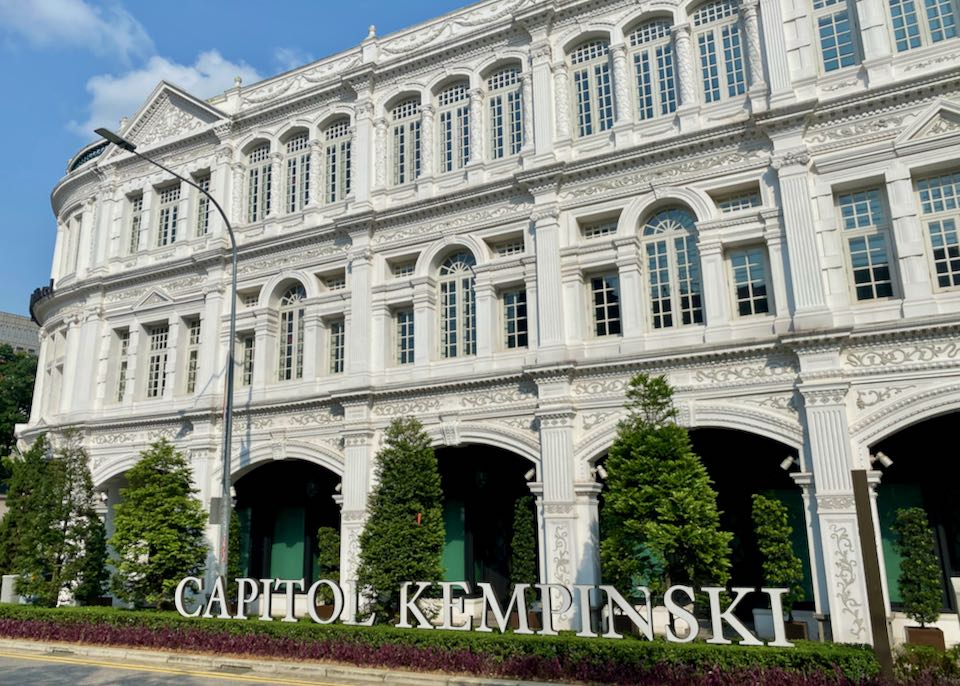
The Capitol Kempinski Hotel in Singapore’s Colonial District.
1. Colonial District
So convenient in the center of downtown, and only a mile from every other district listed below, the range of attractions here is particularly impressive. An easy walk from every hotel in this area are the National Museum, National Gallery, and the Peranakan Museum, which explains the unique culture of descendants from Chinese/Malay marriages. And dominating the area, the wonderful Fort Canning Park is on a hilltop and features a spice garden and war museum. This district, which includes areas called Bencoolen, Bugis, and Bras Basah, is packed with hotels in high-rise blocks and colonial-era buildings, including the world-renowned Raffles. Among the vast array of restaurants are several serving authentic Peranakan cuisine and many offering staggering city views, and there are plenty of fashionable boutiques in the malls and affordable stalls in the famous Bugis Street Market. With several stops along MRT metro lines, the area is also well-connected to the rest of Singapore and the airport.
- Best Luxury Hotels: Raffles Hotel • Capitol Kempinski • Swissôtel The Stamford • Fairmont • InterContinental
- Best Family Hotels: Iyf Funan • Grand Park City Hall
- Best Boutique Hotels: lyf Bugis • Mercure Bugis • Hotel NuVe Heritage • Hotel Fort Canning
- Best Moderate Hotels: Hotel Mi • Ibis on Bencoolen
2. Sentosa Island
Only half a mile from the southern edge of the mainland, this former military base is now Singapore’s brash and buzzing playground. There’s more than enough to satisfy the adults – two golf courses, a marina, and several classy beach clubs – but Sentosa is mostly about families. The majority of the vast 5-star resorts offer special rooms, a children’s pool, and activities for the whole clan. The younger ones will get very excited about all the theme parks, such as Universal Studios, Butterfly Park & Insect Kingdom, and the waterpark and aquarium, among many other outstanding attractions. Outdoor activities include swimming at artificial beaches, cycling along dedicated paths, and numerous water sports – and among all this modern-day hedonism is a 19th-century fort. The excellent range and quality of places to eat and drink include many seaside bistros, often with a playground and live music. And Sentosa is heaps of fun to reach by cable car and so easy to get around by monorail and tram.
- Best Luxury Hotels: Capella • Shangri-La Rasa Sentosa
- Best Family Hotels: Sofitel Sentosa Resort & Spa • W – Sentosa Cove • Shangri-La Rasa Sentosa • Oasia Resort Sentosa • Village Hotel Sentosa
- Best Villas & Suites: Resorts World Sentosa – Equarius Villas • Hotel Michael • Capella
3. Orchard Road
One of the world’s premier shopping precincts stretches about 2 miles from the Colonial District to near the magnificent Botanic Gardens. Tourists often spend far more time than imagined at over 20 malls featuring multi-level department stores, designer-brand boutiques, and more affordable stalls selling souvenirs. This major thoroughfare is also lined with top-end and mid-range hotels, some with colonial-era charm, while eateries range from Michelin-rated bistros to food courts that are ideal for trying local food. The road (and all its hotels and other amenities) is conveniently connected by several MRT metro lines, with links around the city and to the airport.
- Best Luxury Hotels: Shangri-La • Four Seasons • Quincy Hotel • Marriott Tang Plaza • Grand Hyatt
- Best Family Hotels: The St. Regis • Pan Pacific Serviced Suites Orchard
- Best Apartments & Suites: Adina Serviced Apartment Orchard • Lanson Place Winsland • Orchard Point Serviced Apartments • Ascott Orchard
- Best Boutique Hotels: Ji Hotel Orchard • JEN Orchardgateway by Shangri-La
- Best Moderate Hotels: Concorde Hotel • Holiday Inn Orchard City Centre • Holiday Inn Express Orchard Road
4. Marina Bay
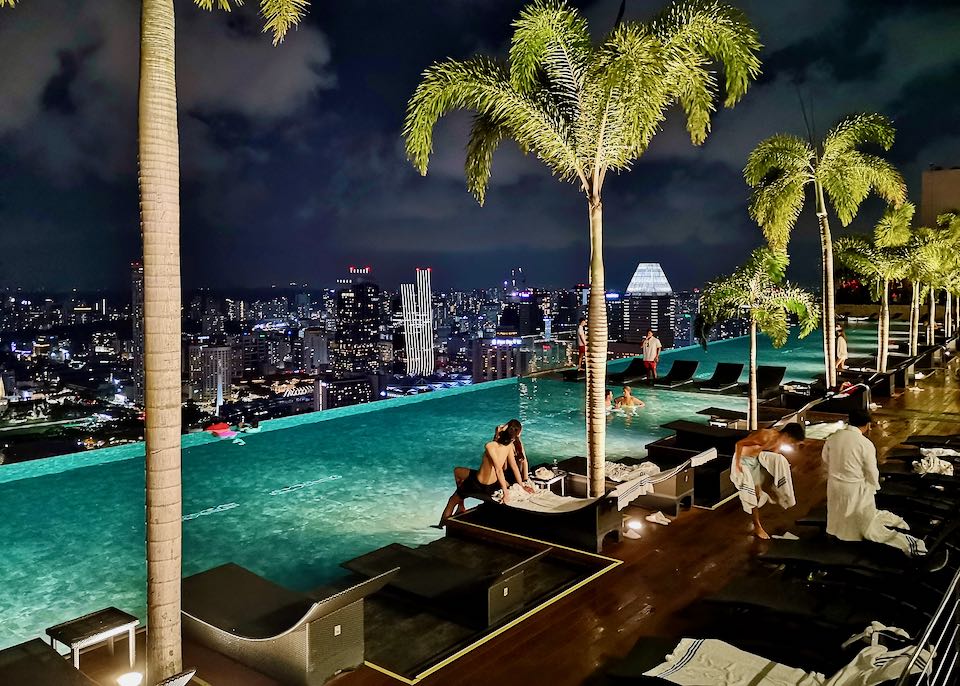
The infinity pool and stunning city views at the Marina Bay Sands Hotel.
This area, built on reclaimed land, offers the city’s most striking architecture, stunning attractions, and sought-after views. Along the western side of the bay (actually more of a freshwater reservoir) is the diminutive statue of Merlion, the symbol of the city. The eastern edge is dominated by the extraordinary Marina Bay Sands hotel complex, now among the most iconic sights in Southeast Asia. Also housing a casino, theater, shopping mall, the ArtScience Museum, and jaw-dropping observation deck, the buildings are brilliantly illuminated during the sound and light shows every evening. Across the water, Singapore Flyer, Asia’s largest observation wheel, provides mind-blowing views of the bay, river, and city. Other attractions include the finest public golf course for views and convenience; the vast, futuristic Gardens by the Bay, home to about one million plants, a waterpark, and a fantastic food court; and cruises on traditional-style bumboats that also head along Singapore River. Most hotels are on the northern side of the bay and well-linked by the excellent MRT metro and walkable to many other inner-city amenities and attractions.
- Best Luxury Hotels: Marina Bay Sands • Fullerton Bay Hotel • Conrad Centennial • Pan Pacific • Ritz-Carlton • PARKROYAL Marina Bay
- Best Suites & Apartment: Ascott Raffles Place
- Best Family Hotel: Westin
- Best Boutique Hotel: QT Singapore
5. Singapore River
Meandering through the inner city from Marina Bay, this waterway is a delightful place to wander along and visit must-sees like the Asian Civilisations Museum in one of the many beautifully maintained colonial buildings facing the river. The numerous quays are used by boats offering cruises and water-taxis heading to Marina Bay and further upriver. These cruises are most appealing after dark, especially during one of the city’s numerous Chinese festivals or the sound and light show at the Marina Bay Sands complex. Both riversides are lined with popular bars, nightclubs, and bistros, some housed in converted warehouses and perfect for trying chili crab, Singapore’s unofficial national dish. Nicely distant from downtown traffic, hotels along the riverside precinct are within an easy walk to an abundance of attractions in the Colonial District and Chinatown and to stations of the excellent MRT metro.
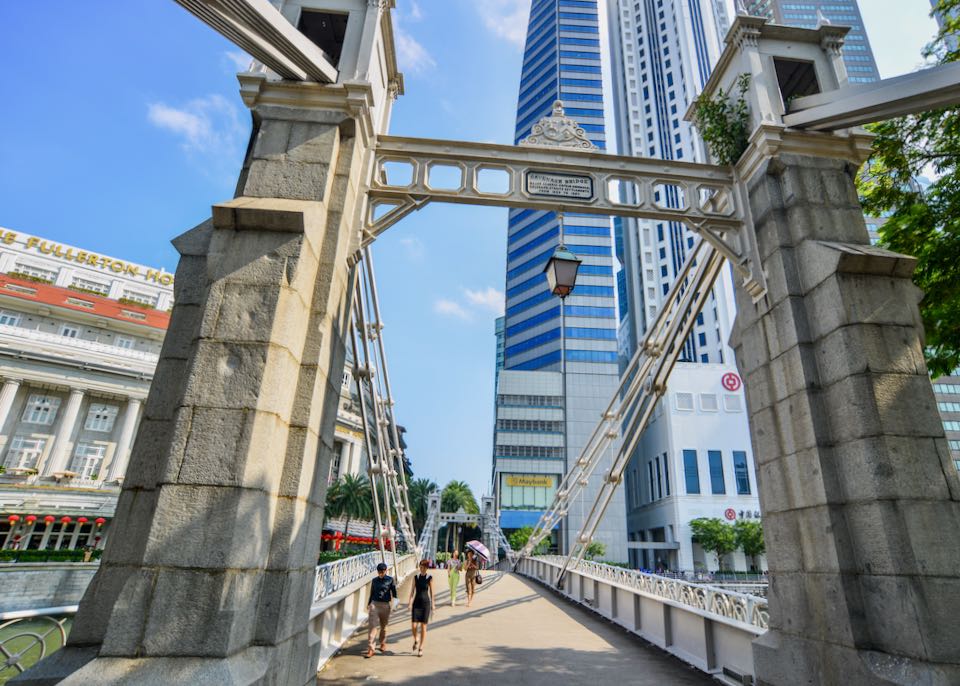
The Cavenagh Bridge across the Singapore River with the Fullerton Hotel in the background. It was built in 1869 and was once the primary means of crossing the Singapore River. It is now pedestrian-only.
- Best Luxury Hotels: Park Regis • Fullerton • Holiday Inn Express Clarke Quay • InterContinental Robertson Quay • Four Points by Sheraton
- Best Apartments: Heritage Collection on Boat Quay • Heritage Collection on Clarke Quay • Fraser Place Robertson Walk
- Best Boutique Hotels: The Warehouse Hotel • Hotel Clover The Arts • M Social
- Best Moderate Hotels: The Quay Hotel • Hotel Bencoolen Hong Kong Street
- Best Budget Hotel: Circular House
6. Chinatown
Settled by Hokkien, Hakka, Cantonese, and Teochew people from the mid-19th century, some of the original buildings across Chinatown have survived the subsequent commercial onslaught and much of the area remains remarkably undisturbed by mass tourism. First stop before exploring this area south of the Singapore River should be the Chinatown Heritage Centre to learn about the city’s early history. Then amble along the narrow streets and check out the frenetic markets, traditional cafés, and colorful Chinese temples. Surprisingly, Chinatown is also home to a revered Hindu temple and a 19th-century mosque. Worth exploring on a bicycle, trishaw, or foodie tour, Chinatown is particularly vibrant and photogenic during one of the many special events, such as the Lantern Festival and Chinese New Year. Conveniently connected to other inner-city attractions by the MRT metro, Chinatown is also the finest place to try authentic food. Hotels are generally more affordable than those in more fancied areas of Singapore, and some are within beautifully converted old warehouses and shopfronts.
- Best Luxury Hotels: Maxwell Reserve • Duxton Reserve • Dorsett
- Best Family Hotel: PARKROYAL on Pickering
- Best Boutique Hotels: D’Hotel • The Scarlet • AMOY • Ann Siang House • Hotel Soloha
- Best Moderate Hotels: Capri by Fraser • Bliss Hotel • Hotel Mono • Hotel 1888 Collection • KēSa House
- Best Budget Hotel: Royal Lodge
7. Little India
Bordering the Colonial District to the south and Kampong Glam to the east, the incense-scented streets, gaudy temples, and mouth-watering smells offer a distinctive vibe and unique character. Along the crowded alleys are various temples, as well as a 100-year-old mosque, while the main thoroughfare, Serangoon Road, is crowded with tempting eateries. These include ‘banana leaf restaurants’, where scoops of curries, rice, and lentils are dolloped onto a banana leaf and eaten by hand. Including areas called Jalan Besar, Lavender, and Farrer Park, most hotels are budget-priced and mid-range, and many are especially good value compared to overpriced areas elsewhere.
- Best Luxury Hotels: Hilton Garden Inn Serangoon • One Farrer Hotel
- Best Boutique Hotels: The Vagabond Club • Arcadia Hotel
- Best Moderate Hotels: Hotel NuVe Urbane • Holiday Inn Express Serangoon
- Best Budget Hotels: Aqueen Heritage Hotel • Blanc Inn
8. Kampong Glam
This area is home to a flourishing Malaysian and, to a lesser degree, the Arab community, but is confusingly also called ‘Arab Street’ after the main thoroughfare. Worth visiting are the Malay Heritage Centre; Sultan Mosque, Singapore’s most important; and Haji Lane, one of the city’s narrowest streets which are lined with historic shop-houses converted to unique boutiques, hip eateries, and trendy tailors. Accommodations range from suites ideal for families in high-rise blocks to adorable boutique hotels, and many eateries offer the sort of cheap and tasty Malaysian food sadly ignored by many tourists.
- Best Luxury Hotels: Andaz by Hyatt • Traveltine
- Best Family Hotels: Pan Pacific Serviced Suites Beach Road • PARKROYAL Serviced Suites
- Best Boutique Hotels: Hotel Clover • Hi Hotel • The Sultan
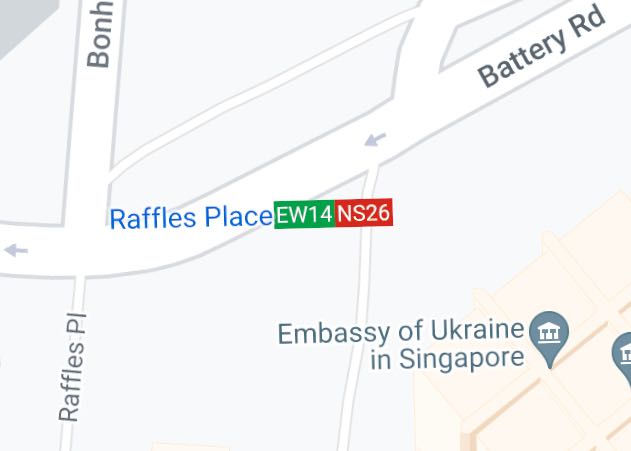
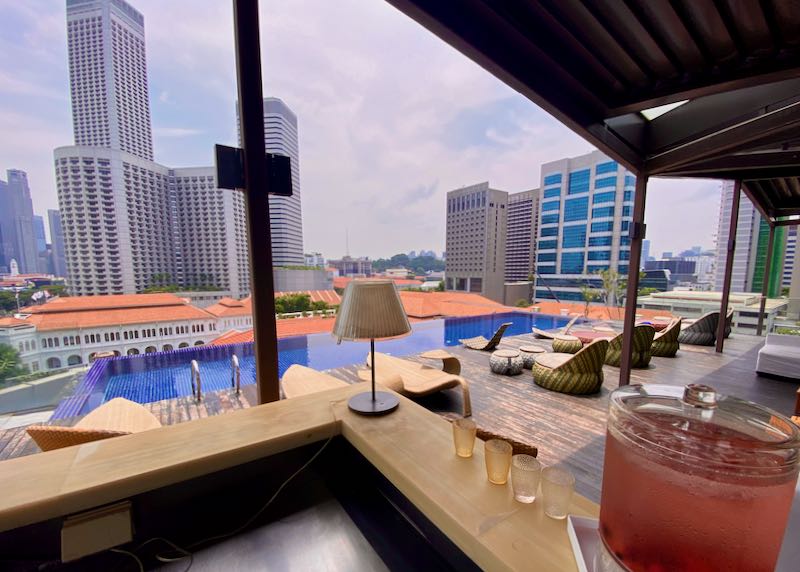
About Santorini Dave